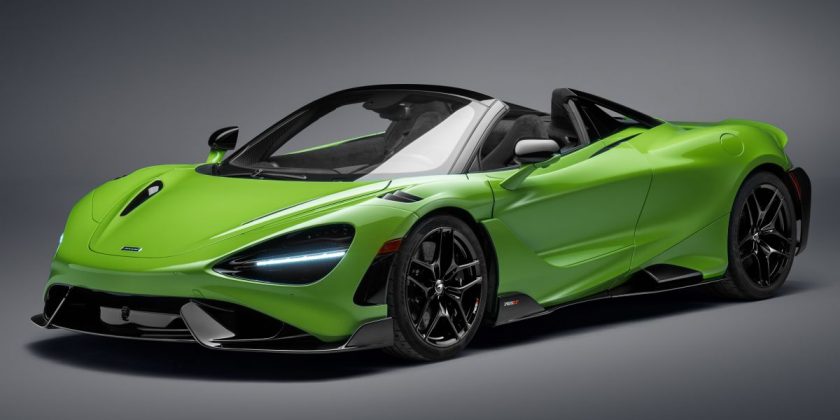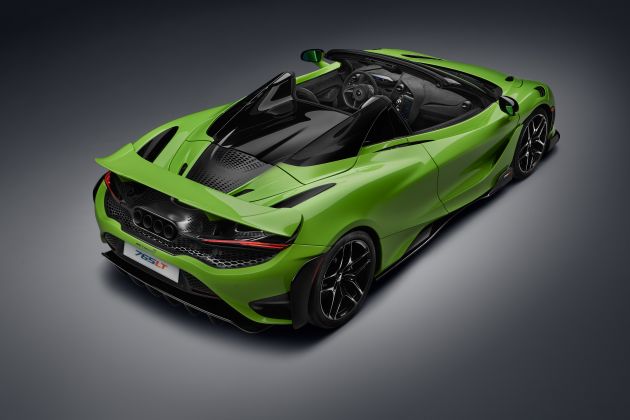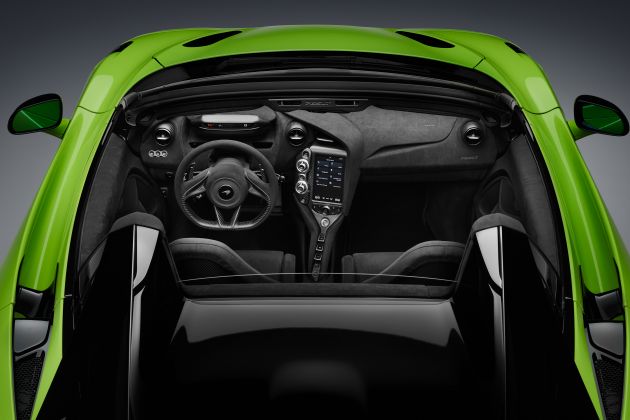This is the new McLaren 765LT Spider, which is essentially the convertible version of the 765LT coupe that the Woking-based carmaker unveiled last March. Just like the fixed-roof model, only 765 units of the 765LT Spider will be produced, with each one carrying a starting price tag of 310,500 British pounds (around RM1.8 million).
The party piece here is the electrically operated, one-piece roof, which is made from carbon-fibre and can be lowered or raised using dedicated buttons on the centre console. According to McLaren, the process can be done at speeds of up to 50 km/h and takes 11 seconds to complete.
The company adds that the roof mechanism (consisting of eight electric motors) is described as being among the world’s quickest and quietest, with occupants said to experience a sound no louder than 60 dBA during operation. This is twice as quiet when compared to what was used for the previous 675LT Spider.
To add to passenger comfort, there’s also a high-density foam core between the panel and the internal headlining. This, along with the lack of a central seal that previously ran side-to-side across the roof panel, reduces noise and creates more headroom.
McLaren also notes the roof’s extended length allows the tops of the A-pillars to be pushed further forward by 80 mm to enhance the sense of space, while making ingress and egress easier with larger door openings. The roof also plays an integral role in the car’s structure, creating a full carbon-fibre shell when closed.
Thanks to the well-engineered MonoCage II-S carbon-fibre monocoque, there’s no need for additional bracing to ensure the structure provides the same strength and stiffness as the coupe. As a result, the addition of the retractable roof and accompanying operating mechanism makes the 765LT Spider 49 kg heavier than the coupe, while being 80 kg lighter than a 720S Spider.
Drivers will also be able to lower the rear window if they want to hear the noise provided by the M840T 4.0 litre twin-turbo V8 more clearly. The outputs are identical to the coupe, with the mill providing 765 PS (755 hp) at 7,500 rpm and 800 Nm of torque at 5,500 rpm.
Drive goes to the rear wheels via a seven-speed Sequential Shift Gearbox (SSG), allowing for a zero to 100 km/h time of 2.8 seconds and a top speed of 330 km/h – these are identical to the coupe. The rest of the package is the same too, including adaptive dampers, Proactive Chassis Control II (PCC II), Pirelli P Zero Trofeo R tyres, 20-inch forged wheels and carbon-ceramic brake discs with six-piston front and four-piston rear forged aluminium calipers.
The aerodynamic carbon-fibre bodywork is also shared with the coupe, from the front splitter, new front bumper lower door blades and side skirts, to the wraparound rear bumper and active rear wing. All other lightweight parts like the titanium exhaust system with quad tailpipes and a lithium-ion battery are also carried over.
This weight-saving initiative extends to the interior, which, again, is nearly identical to the coupe. Inside, you’ll find carbon-fibre-shelled seats trimmed in Alcantara, with the latter material also appearing on the steering wheel, dashboard and doors. Elsewhere, the door pockets are replaced by nets, while carbon-fibre is used for many key structures including the central tunnel.
As with the coupe, the floor carpet, air-conditioning system and audio system are also removed, although the latter two can be specified back in at no extra cost. Other available options include the seats from the Senna, a front axle lifter, a 360-degree, with McLaren Special Operations on hand to attend to the further customisation demands from customers. These include the Clubsport Pack and the LT Black Pack for a more track-focused spec or a stealthier look, along with whatever the wallet allows.
Source: Read Full Article



